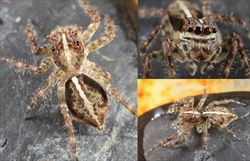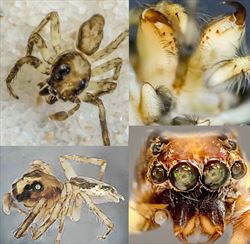
Examples of live Yamangalea lubinae
Illustrator (and ©) I.R. Macaulay

Aspects of the general morphology of Yamangalea
Illustrators (and ©) IR Macaulay, R. Whyte (BR)

Palp and epigyne morphology of Yamangalea lubinae and Y. frewana
Illustrators (and ©) M. Zabka (Tl, BL) (MP), R. Whyte (TM, BM), W. Maddison (TR, BR) (MP)
Yamangalea Maddison, 2009
Taxonomy
Yamangalea has two described species; one in Australia, Yamangalea lubinae, the other in Papua-New Guinea. The genus is part of an Australasian radiation of five genera centred on Papua New Guinea, the others being Allococalodes, Cocalodes, Cucudeta and Tabuina, though this is the only species of the group known from Australia (Żabka 2012, Maddison 2015). Further information on the genus and described species in Australia can be found in Richardson and Żabka (2017) and Whyte and Anderson (2017).
Description
Yamangalea lubinae is a small to medium-sized spider, ranging in body length from 3 to 5 mm. The head, viewed from above, is rectangular with a distinctly rounded rear, widest behind the posterior lateral eyes, therefore moderately pear-shaped but not much narrowed at the front. The carapace is high, peaking at the posterior median eyes and then immediately sloping to the rear. Chelicerae have three, widely-placed retromarginal teeth (plurident) and three promarginal teeth. The posterior median eyes are almost as large as the posterior lateral eyes. The abdomen is rhomboid-ovate. The fourth pair of legs is longest. The first pair is not more strongly built than the remainder.
The male’s palp has a thick blunt, curved embolus arising on the distal edge of the tegulum. The tegulum is oval to pear-shaped, without a proximal lobe and with a large, distinctive hook-like median sclerite and a second, thorn-like one nearer the embolus. The palpal tibia has two short apophyses close together, one ventral, smaller and thumb-shaped and the second lateral, longer and bifurcate (two lobed).
The female’s epigyne has a heavily-sclerotized posterior hood-like opening appearing like a nose with flaring nostrils. The copulatory openings are located at the lateral edges of this sclerite. The insemination ducts are convoluted, located immediately anterior to the hood. Roundish spermathecae are anterior to the ducts.
Biology
In New Guinea, Yamangalea was collected by sweeping tree trunks and branches (Maddison 2009).
Distribution
The Australian species has been collected in warmer, wetter parts of Queensland, notably around Cairns.
References
Maddison, W.P. 2009. New cocalodine jumping spiders from Papua New Guinea (Araneae: Salticidae: Cocalodinae). Zootaxa 2021, 1-22.
Maddison, W.P. 2015. A phylogenetic classification of jumping spiders (Araneae: Salticidae). Journal of Arachnology 43, 231-292.
Richardson, B.J. & Żabka, M. 2017. Salticidae. Arachnida: Araneomorphae. Canberra, Australian Faunal Directory. Australian Biological Resources Study, at https://biodiversity.org.au/afd/taxa/SALTICIDAE.
Whyte, R. & Anderson, G. 2017. A field guide to the spiders of Australia. Clayton: CSIRO Publishing 451pp.
Żabka, M. 2012. Phlegra Simon, 1876, Phintella Strand 1906 and Yamangalea Maddison, 2009 (Arachnida: Araneae: Salticidae) — new species and new generic records for Australia. Zootaxa 3176, 61-68.
* The information sheet should be read in the context of the associated diagrams and photographs. Diagrams explaining anatomical terms can be found in the ‘Salticidae’ pictures at the beginning of the list of genera.